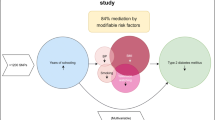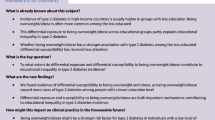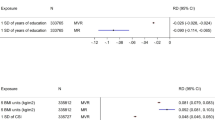Abstract
Background and objective
Education might be causal to type 2 diabetes mellitus (T2DM). We triangulated cohort and genetic evidence to consolidate the causality between education and T2DM.
Methods
We obtained observational evidence from the English Longitudinal Study of Ageing (ELSA). Self-reporting educational attainment was categorised as high (post-secondary and higher), middle (secondary), and low (below secondary or no academic qualifications) in 6,786 community-dwelling individuals aged ≥ 50 years without diabetes at ELSA wave 2, who were followed until wave 8 for the first diabetes diagnosis. Additionally, we performed two-sample Mendelian randomisation (MR) using an inverse-variance weighted (IVW), MR-Egger, weighted median (WM), and weighted mode-based estimate (WMBE) method. Steiger filtering was further applied to exclude single-nucleotide polymorphisms (SNPs) that were correlated with an outcome (T2DM) stronger than exposure (education attainment).
Results
We observed 598 new diabetes cases after 10.4 years of follow-up. The adjusted hazard ratios (95% CI) of T2DM were 1.20 (0.97–1.49) and 1.58 (1.28–1.96) in the middle- and low-education groups, respectively, compared to the high-education group. Low education was also associated with increased glycated haemoglobin levels. Psychosocial resources, occupation, and health behaviours fully explained these inverse associations. In the MR analysis of 210 SNPs (R2 = 0.0161), the odds ratio of having T2DM per standard deviation-decreasing years (4.2 years) of schooling was 1.33 (1.01–1.75; IVW), 1.23 (0.37–4.17; MR-Egger), 1.56 (1.09–2.27; WM), and 2.94 (0.98–9.09; WMBE). However, applying Steiger filtering attenuated most MR results towards the null.
Conclusions
Our inconsistent findings between cohort and genetic evidence did not support the causality between education and T2DM.

Similar content being viewed by others
Availability of data and material
ELSA data were made available through the UK Data Archive (https://www.ukdataservice. ac.uk/). Genetic data used in this research are publicly available from https://www.mrbase.org/.
References
Khan MAB, Hashim MJ, King JK et al. (2019) Epidemiology of type 2 diabetes – Global burden of disease and forecasted trends. J Epidemiol Glob Health 10(1):107
Magliano DJ, Chen L, Islam RM et al. (2021) Trends in the incidence of diagnosed diabetes: a multicountry analysis of aggregate data from 22 million diagnoses in high-income and middle-income settings. Lancet Diabet Endocrinol 9(4):203–211
American Diabetes Association. 3. Prevention or delay of type 2 diabetes: Standards of medical care in diabetes-2021. Diabetes Care.44:S34–9.
Steele CJ, Schottker B, Marshall AH et al. (2017) Education achievement and type 2 diabetes-what mediates the relationship in older adults? Data from the ESTHER study: a population-based cohort study. BMJ Open 7(4):e013569
Demakakos P, Marmot M, Steptoe A (2012) Socioeconomic position and the incidence of type 2 diabetes: the ELSA study. Eur J Epidemiol 27(5):367–378
Lee TC, Glynn RJ, Peña JM et al. (2011) Socioeconomic status and incident type 2 diabetes mellitus: data from the women’s health study. PLoS One 6(12):e27670
Maty SC, Everson-Rose SA, Haan MN et al. (2005) Education, income, occupation, and the 34-year incidence (1965–99) of type 2 diabetes in the alameda county study. Int J Epidemiol 34(6):1274–1281
Qi Y, Koster A, van Boxtel M et al. (2019) Adulthood socioeconomic position and type 2 diabetes mellitus—A comparison of education, occupation, income, and material deprivation: the maastricht study. Int J Environ Res Public Health 16(8):1435
Moody A, Cowley G, Ng Fat L et al. (2016) Social inequalities in prevalence of diagnosed and undiagnosed diabetes and impaired glucose regulation in participants in the health surveys for england series. BMJ Open. 6(2):e010155
American Diabetes Association (2021) Classification and diagnosis of diabetes: standards of medical care in diabetes—2021. Diabetes Care 44:S15-33
Cao M, Cui B. Association of educational attainment with adiposity, type 2 diabetes, and coronary artery diseases: a Mendelian randomization study. Front Public Health [Internet]. 2020 Apr 22;8. Available from: https://www.frontiersin.org/article/https://doi.org/10.3389/fpubh.2020.00112/full
Adams CD, Boutwell BB (2020) Can increasing years of schooling reduce type 2 diabetes (T2D)?: evidence from a Mendelian randomization of T2D and 10 of its risk factors. Sci Rep 10(1):12908
Hagenaars SP, Gale CR, Deary IJ et al. (2017) Cognitive ability and physical health: a mendelian randomization study. Sci Rep 7(1):2651
Liang J, Cai H, Liang G et al. (2021) Educational attainment protects against type 2 diabetes independently of cognitive performance: a Mendelian randomization study. Acta Diabetol 58(5):567–574
Lawlor DA, Tilling K, Smith GD (2016) Triangulation in aetiological epidemiology. Int J Epidemiol 45(6):1866–1886
Na-Ek N. Mendelian Randomisation (MR): From a naturally randomised process to a trendy research design. Chiangrai Med J [Internet]. 2021;12(3):155–79. Available from: https://he01.tci-thaijo.org/index.php/crmjournal/article/view/242585
Walker VM, Davey Smith G, Davies NM et al. (2017) Mendelian randomization: a novel approach for the prediction of adverse drug events and drug repurposing opportunities. Int J Epidemiol 46(6):2078–2089
Lawlor DA, Harbord RM, Sterne JAC et al. (2008) Mendelian randomization: using genes as instruments for making causal inferences in epidemiology. Stat Med 27(8):1133–1163
Smith GD, Davies NM, Dimou N et al. STROBE-MR: Guidelines for strengthening the reporting of Mendelian randomization studies. PeerJ Prepr [Internet]. 2019;7:e27857v1. Available from: https://doi.org/10.7287/peerj.preprints.27857v1
Clemens S, Phelps A, Oldfield Z et al. English Longitudinal Study of Ageing: Waves 0-8, 1998-2017. [data collection]. 30th ed. UK Data Service. 2019. SN: 5050, https://doi.org/10.5255/UKDA-SN-5050-17.
NatCen Social Research and UCL. Health Survey for England 2016: Methods [Internet]. 2017 [cited 2021 Apr 17]. Available from: http://healthsurvey.hscic.gov.uk/media/63778/HSE2016-Methods-text.pdf
Hamad R, Nguyen TT, Bhattacharya J et al. (2019) Educational attainment and cardiovascular disease in the United States: A quasi-experimental instrumental variables analysis. Rahimi K, editor. PLOS Med. 16(6):e1002834.
Hemani G, Zheng J, Elsworth B et al. (2018) The MR-Base platform supports systematic causal inference across the human phenome. Elife 7:e34408
Lee JJ, Wedow R, Okbay A et al. (2018) Gene discovery and polygenic prediction from a genome-wide association study of educational attainment in 1. 1 million individuals. Nat Genet. 50(8):1112–21
Morris AP, Voight BF, Teslovich TM et al. (2012) Large-scale association analysis provides insights into the genetic architecture and pathophysiology of type 2 diabetes. Nat Genet 44(9):981–990
Prins BP, Kuchenbaecker KB, Bao Y et al. (2017) Genome-wide analysis of health-related biomarkers in the UK Household Longitudinal Study reveals novel associations. Sci Rep 7(1):1–9
Bowden J, Davey Smith G, Burgess S (2015) Mendelian randomization with invalid instruments: effect estimation and bias detection through Egger regression. Int J Epidemiol 44(2):512–525
Bowden J, Smith GD, Haycock PC et al. (2016) Consistent estimation in Mendelian randomization with some invalid instruments using a weighted median estimator. Genet Epidemiol 40(4):304–314
Hartwig FP, Smith GD, Bowden J (2017) Robust inference in summary data Mendelian randomization via the zero modal pleiotropy assumption. Int J Epidemiol 46(6):1985–1998
Burgess S, Davey Smith G, Davies NM et al. Guidelines for performing Mendelian randomization investigations. Wellcome Open Res [Internet]. 2020 Apr 28;4:186. Available from: https://wellcomeopenresearch.org/articles/4-186/v2
Hemani G, Tilling K, Smith GD (2017) Orienting the causal relationship between imprecisely measured traits using GWAS summary data. PLOS Genet 13(11):e1007081
Lambert JC, Ibrahim-Verbaas CA, Harold D et al. (2013) Meta-analysis of 74,046 individuals identifies 11 new susceptibility loci for Alzheimer’s disease. Nat Genet 45(12):1452–1458
Anderson EL, Howe LD, Wade KH et al. (2020) Education, intelligence and Alzheimer’s disease: evidence from a multivariable two-sample Mendelian randomization study. Int J Epidemiol 49(4):1163–1172
Larsson SC, Traylor M, Malik R et al. (2017) Modifiable pathways in Alzheimer’s disease: Mendelian randomisation analysis. BMJ. 6(359):j5375
Deng L, Zhang H, Yu K (2020) Power calculation for the general two-sample Mendelian randomization analysis. Genet Epidemiol 44(3):290–299
Proschan MA, Waclawiw MA (2000) Practical guidelines for multiplicity adjustment in clinical trials. Control Clin Trials 21(6):527–539
Okura Y, Urban LH, Mahoney DW et al. (2004) Agreement between self-report questionnaires and medical record data was substantial for diabetes, hypertension, myocardial infarction and stroke but not for heart failure. J Clin Epidemiol 57(10):1096–1103
Burgess S, Thompson SG (2011) Avoiding bias from weak instruments in Mendelian randomization studies. Int J Epidemiol 40(3):755–764
Acknowledgements
This research project was supported by the Thailand Science Research and Innovation Fund and the University of Phayao (Grant No. FF64-UoE039). However, the funding body did not involve the design, analysis, and interpretation of this study. The English Longitudinal Study of Ageing (ELSA) is supported by the National Institute on Ageing (grant numbers: 2RO1AG7644 and 2RO1AG017644–01A1) and a consortium of the UK government departments co-ordinated by the Office for National Statistics. Additionally, we would like to thank researchers from the MR-Base Collaboration who made the IEU GWAS database publicly available.
Funding
The original data creators, depositors or copyright holders, the funders of the Data Collections, and the UK Data Service/UK Data Archive bear no responsibility for analysing or interpreting this study.
Author information
Authors and Affiliations
Contributions
NN conceived the study aims and design and obtained access to ELSA data. NN, JS, and AA contributed to the literature reviewing, data cleaning, data analyses, interpretation of the findings. NN and SB developed the initial and subsequent manuscripts. PC and PD critically revised the initial manuscript, and all authors participated in further revisions. The final manuscript was read and approved by all authors before submission.
Corresponding author
Ethics declarations
Conflict interest
The authors have no conflicts of interest to declare that are relevant to the content of this article.
Code availability
In this study, all analyses were performed using STATA version 16MR (StataCorp, LLC) package "stcox", "mixed", and "mrrobust". We also used R version 3.6 package "TwoSampleMR" for the genetic instrument extraction and harmonisation. Additional R script and STATA do-file for the analyses were available upon request.
Ethics approval
The English Longitudinal Study of Ageing has been approved by the National Research Ethics Service (London Multicentre Research Ethics Committee (MREC/01/2/91)). For the MR study, specific ethical approval has been obtained individually in the original genome-wide association studies (GWAS).
Consent to participate
Not applicable (specific consent was obtained in the original studies).
Additional information
This article belongs to the topical collection Health, Education and Psycho-Social Aspects, managed by Massimo Porta and Marina Trento.
Publisher's Note
Springer Nature remains neutral with regard to jurisdictional claims in published maps and institutional affiliations.
Supplementary Information
Below is the link to the electronic supplementary material.
Rights and permissions
About this article
Cite this article
Na-Ek, N., Srithong, J., Aonkhum, A. et al. Educational level as a cause of type 2 diabetes mellitus: Caution from triangulation of observational and genetic evidence. Acta Diabetol 59, 127–135 (2022). https://doi.org/10.1007/s00592-021-01795-7
Received:
Accepted:
Published:
Issue Date:
DOI: https://doi.org/10.1007/s00592-021-01795-7




